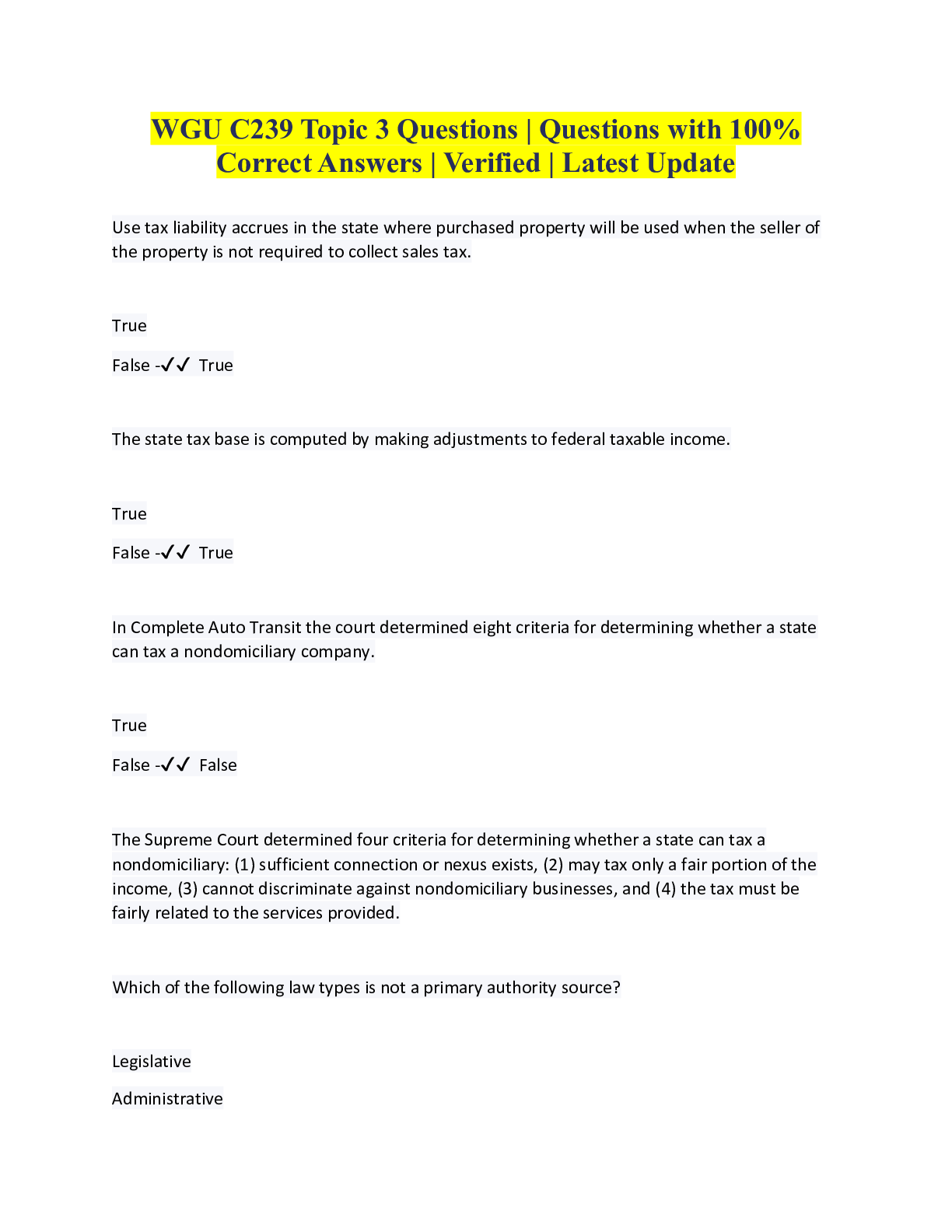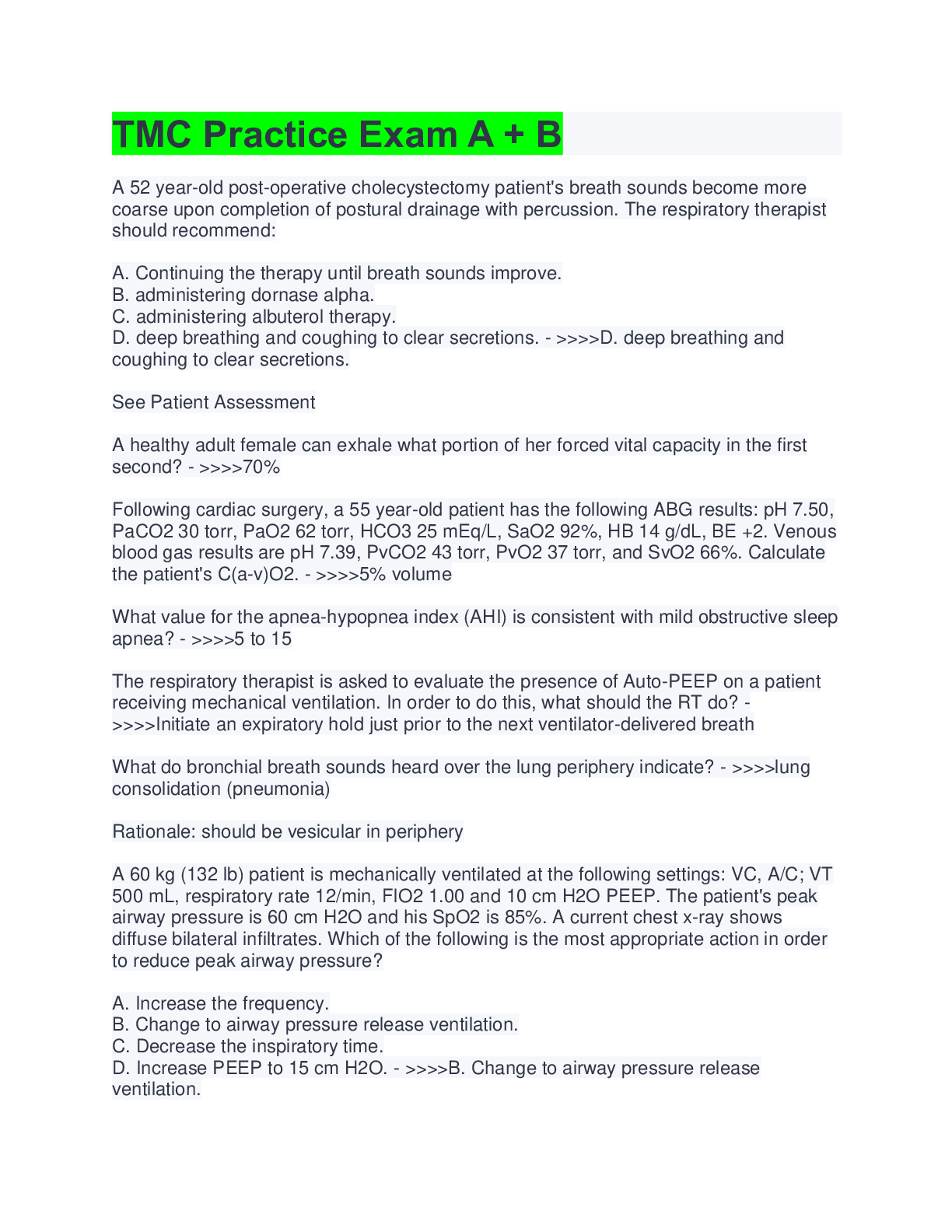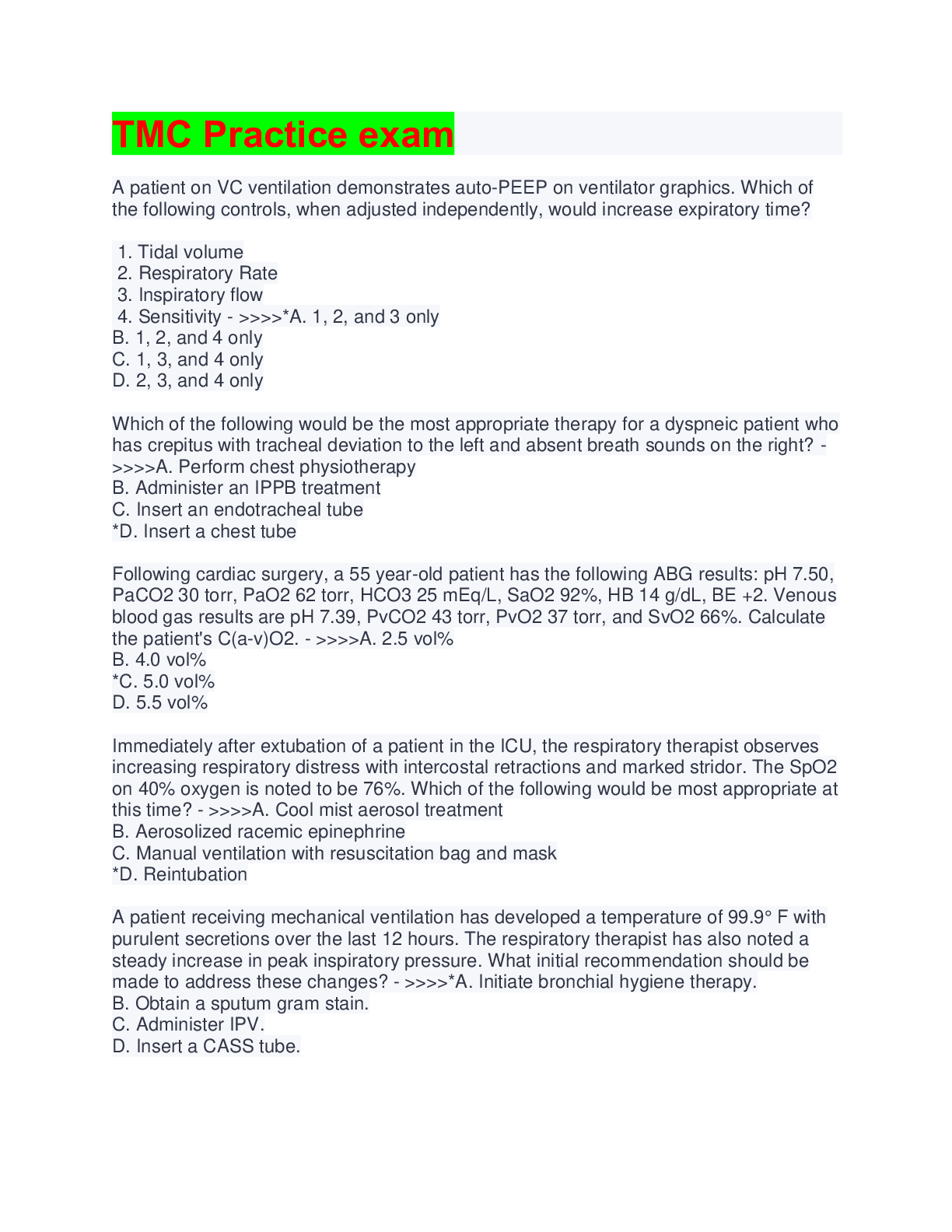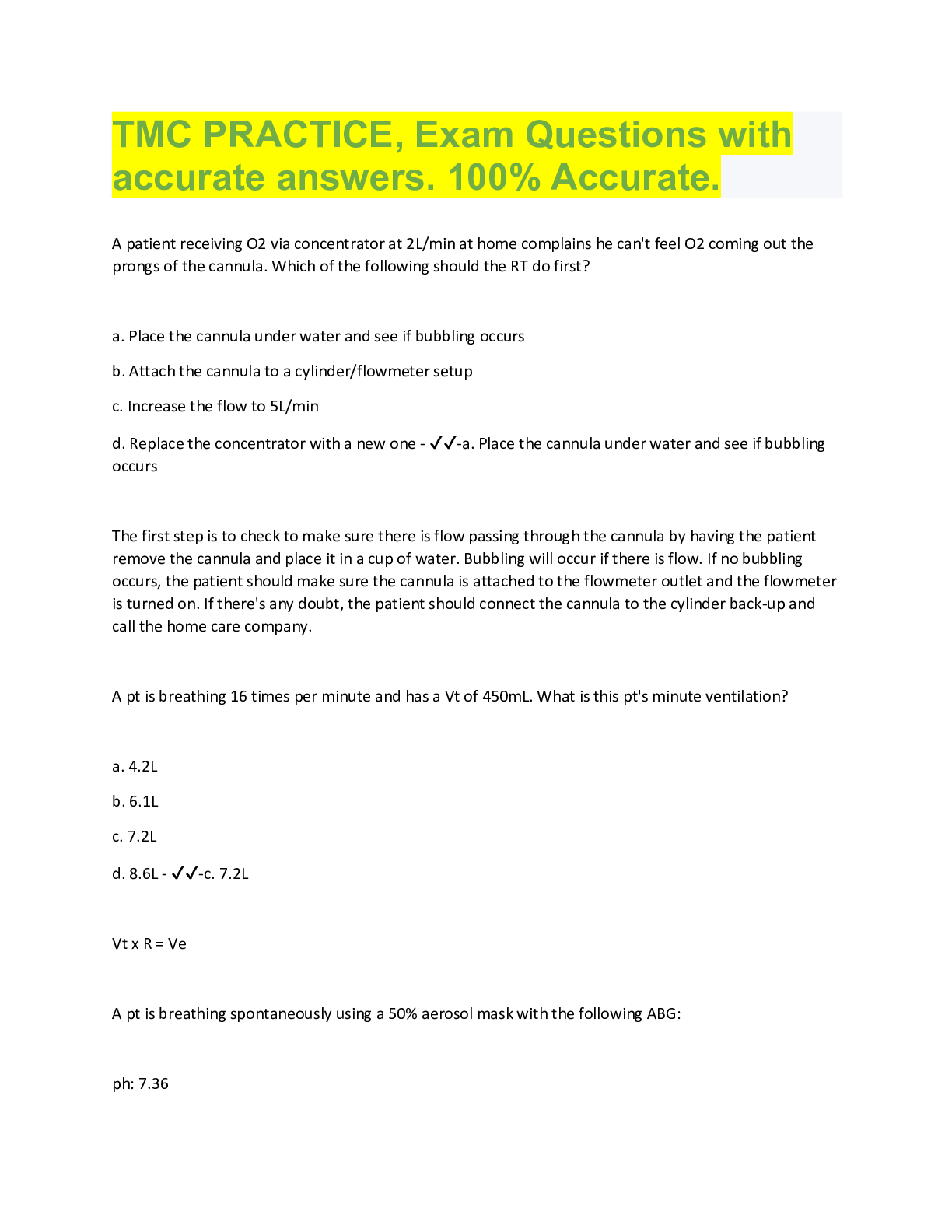*NURSING > QUESTIONS & ANSWERS > Troy University, MontgomeryNSG 3370 ( 316 STUDY QUESTIONS WITH 100% CORRECT ANSWERS AND EXPLANATIONS (All)
Troy University, MontgomeryNSG 3370 ( 316 STUDY QUESTIONS WITH 100% CORRECT ANSWERS AND EXPLANATIONS )
Document Content and Description Below
1. During pregnancy, dyspnea accompanied by increased respiratory rate, cough, rales, or respiratory distress raises concerns of: peripartum cardiomyopathy Explanation: Dyspnea accompanied by incr... eased respiratory rate, cough, rales, or respiratory distress raises concerns of possible infection, asthma, pulmonary embolus, or peripartum cardiomyopathy. 2. The middle section of the thoracic cavity containing the esophagus, trachea, heart, and great vessels is the: mediastinum Explanation: The middle section of the thoracic cavity containing the esophagus, trachea, heart, and great vessels is the mediastinum. The right and left pleural cavities, are on either side of the mediastinum and those contain the lungs. The visceral pleura encloses the lung. The pericardium surrounds the heart. 3. A patient is unable to identify the smell of an orange. This inability could reflect an abnormality in cranial nerves: CN I Explanation: Cranial Nerve I is the olfactory nerve responsible for the sense of smell. To test the sense of smell, the examiner presents the patient with familiar and nonirritating odors. A person should normally perceive odor on each side and correctly identify the source. Cranial Nerves II and III assess vision and pupillary reaction. Cranial Nerve VIII tests the hearing and balance. 4. A transient ischemic attack is: a transient episode of neurologic dysfunction by focal brain, spinal cord, or retinal ischemia, without acute infarction Explanation: TIA is now defined as “a transient episode of neurological dysfunction caused by focal brain, spinal cord, or retinal ischemia, without acute infarction.” Ischemic stroke is “an infarction of central nervous system tissue” that may be symptomatic or silent. The other terms are not related to the new definitions. 5. The term asteatosis refers to: skin that is dry, flaky, rough, and often itchy Explanation: Physiologic changes of aging include loss of elastic turgor, and wrinkling. Skin that appears dry, flaky, rough, and itchy is termed asteatosis. Sun exposure can cause damage to the skin resembling an appearance as weather beaten, thickened, yellowed, and deeply furrowed. Seborrheic keratosis appear as raised, yellowish lesions that feel greasy, velvety, or warty. Painful vesicular lesions in a dermatomal distribution may suggest herpes zoster.6. An enlarged liver with a smooth tender edge may suggest: right-sided heart failure. Explanation: An enlarged liver with a smooth, tender edge suggests inflammation, as in hepatitis, or venous congestion, as in right-sided heart failure. Cirrhosis, hematochromatosis (increased amount of iron in the blood), and lymphoma produce an enlarged liver with a firm, nontender edge. An enlarged liver that is firm or hard and has an irregular edge or surface suggests hepatocellular carcinoma. 7. New onset hypertension with proteinuria or end-organ damage is: preeclampsia Explanation: Chronic hypertension occurs when systolic BP (SBP) >140 mm Hg or diastolic BP (DBP) >90 mm Hg documented prior to pregnancy, before 20 weeks, or beyond 12 weeks postpartum. Gestational hypertension refers to elevated blood pressure detected after 20 weeks gestation in the absence of proteinuria. Pre-eclampsia occurs in a woman who was previously normotensive but now has new onset hypertension with either proteinuria or end-organ damage. Primary hypertension, formerly known as essential hypertension, is a disorder which is associated with elevated blood pressure and an unidentifiable cause. 8. The psoas muscle group and muscles of the abdominal wall assist with: flexion Explanation: The psoas muscle group and muscles of the abdominal wall assist with flexion. The deep intrinsic muscles of the back assist with extension. The abdominal muscles and intrinsic muscles of the back assist with rotation. Lateral bending uses the abdominal muscles and intrinsic muscles of the back. 9. "Preterm small for gestational age" (SGA) infants are prone to: hypocalcemia Explanation: "Preterm appropriate for gestational age" (AGA) infants are prone to respiratory distress syndrome, apnea, patent ductus arteriosus with left-to-right shunt, and infection. "Preterm small for gestational age" (SGA) infants are more likely to experience asphyxia, hypoglycemia, and hypocalcemia. 10. Swelling noted 1-2 inches below the knee joint and on the medial surface of the knee would be suggestive of:anserine bursitis Explanation: Swelling 1-2 inches below the knee joint and on the medial surface would be suggestive of anserine bursitis. Swelling over the tibial tubercle suggests infrapatellar bursitis. Swelling over the patella suggests prepatellar bursitis. Semimembranous bursitis would be suggested by swelling on the posterior and medial surface of the knee. 11. A patient states that the only way he can sleep at night is to use several pillows or to sleep upright in a recliner. This sleep pattern is most consistent with: obstructive lung disease Explanation: With obstructive lung disease, the patient experiences orthopnea, dyspnea that occurs when the patient lies down but improves with sitting. Therefore, the patient would use several pillows or sleep upright in a recliner. Orthopnea is seen in obstructive lung disease, mitral stenosis, and heart failure. Paroxysmal nocturnal dyspnea describe episodes of sudden dyspnea that cause the patient to awaken from sleep where the patient must sit up, walk, or stand for it to resolve. Coughing and wheezing may also occur. Angina pectoris commonly creates chest pain or shortness of breath. Jugular venous pressure reflects right atrial pressure and volume status. In cases of cardiac or pulmonary dysfunction, jugular venous pressures usually raise. 12. A positive obturator sign would elicit pain in the: right hypogastric area Explanation: Assessment of the obturator sign is performed by flexing. By flexing the patient's right thigh at the hip with the knees bent, rotating the leg internally at the hip. If this causes increased pain in the right epigastric area, then the obturator sign is positive. Hypogastric pain occurs as the obturator muscle rubs an inflamed appendix. 13. The lateral bone that serves as a strut between the scapula and the sternum is known as the: clavicle Explanation: The lateral bone that serves as a strut between the scapula and the sternum is known as the clavicle. The humerus is the long bone of the upper arm. The acromion process is an extension of the spine of the scapula and located at the highest point of the shoulder. The thick curved extension of the superior border of the scapula is referred to as the coracoid process. 14. When examining the foot of a patient, the nurse practitioner notes focal heel tenderness on palpation of the plantar fascia. This could be suggestive of: plantar fasciitis Explanation: Focal heel tenderness on palpation of the plantar fascia suggests plantar fasciitis. Bone spurs maybe present on the calcaneus as bony projections and may cause numbness, tenderness, or pain. Localized tenderness on examination of the ankle joint could be suggestive of arthritis, infection of the ankle, or ligamentous injury. Tenderness along the posterior medial malleolus suggests posterior tibial tendinitis. 15. When examining the conjunctiva and sclera, have the patient look upward and then: depress both lower lids with your thumbs, exposing the sclera and conjunctiva Explanation: When examining the conjunctiva and the sclera, the best way to expose these structures is to have the patient look upward and depress both lower lids with your thumbs. Covering one eye while visualizing the other eyes checks for visual acuity. Observing for excessive tearing or dryness assesses the lacrimal apparatus. Checking the position of the lids may identify variations and abnormalities in the eyelids. 16. The groove of the metacarpophalangeal joint can be palpated by having the patient: flex his hand Explanation: The groove of the metacarpophalangeal joints can be palpated by having the patient flex his hand. 17. A patient complains of shooting pains below the knee radiating into the lateral leg and calf. This type of low back pain is referred to as: radicular low back pain Explanation: Radicular low back pain, or sciatica, presents with shooting pains below the knee, into the lateral leg or posterior calf. It may be accompanied by paresthesias and/or weakness in the affected leg. Mechanical low back pain often arises from muscle and ligament injuries (~70%) or age-related intervertebral disc or facet disease. Common symptoms include aching pain in the lumbosacral area that radiates to the upper leg. Common risk factors include heavy lifting, poor conditioning, and obesity. Lumbar spinal stenosis or "pseudoclaudication" refers to pain in the back or legs with walking that improves with rest, lumbar flexion, or both. 18. When assessing a 3-month-old for developmental dysplasia of the hips (DDH), which one of the following symptoms would be suspicious of dysplasia? Limitation of abduction of the affected extremity, shortening of the femur and positive Ortolani's sign Explanation: Developmental dysplasia of the hips (DDH) presents with limitation of abduction, shortening of the extremity, as the head of the femur does not fit into the acetabulum, and a positive Ortolani's (it clicks when maneuvered). DDH presents with asymmetry of the gluteal folds. 19. A patient presents with right upper quadrant and upper abdominal pain. Acute cholecystitis is suspected because the pain radiates to the:right scapula area Explanation: Acute cholecystitis presents with right upper quadrant and upper abdominal pain radiating to the right scapular area. It is usually steady and aching. Pain in the epigastric area could be associated with peptic ulcer or dyspepsia. Cancer of the stomach can present with epigastric pain. Acute mechanical colon obstruction presents with pain in the lower abdomen. 20. The preauricular lymph node is located: in front of the ear Explanation: The preauricular lymph nodes are located in front of the ear. The tonsillar lymph nodes are at the angle of the mandible. The occipital lymph nodes are located at the base of the skull posteriorly. The posterior auricular nodes are superficial to the mastoid process. 21. Cessation of the menses for 12 months is termed: menopause Explanation: Menopause is defined as cessation of menses for 12 months, progressing through several stages of erratic cyclical bleeding. Oligomenorrhea is infrequent bleeding with menses occurring greater than 35-day intervals, or 4-9 menstrual cycles per year. Menorrhagia refers to excessive or prolonged menstrual flow occurring at regular intervals. Metrorrhagia refers to intermenstrual bleeding. 22. The gastrocnemius and soleus muscles are located by palpating the: posterior surface of the lower leg Explanation: The gastrocnemius and soleus muscles are located by palpating the posterior surface of the lower leg. 23. One cause of nasal septum perforation may be: intranasal use of cocaine Explanation: Perforation of the nasal septum could be caused by trauma, surgery, and intranasal use of cocaine or amphetamines. Nasal polyps obstruct air flow but there is no relationship to nasal septum perforation. Cystic fibrosis or chronic sinusitis are not associated with nasal perforation. 24. Tenderness in the costovertebral angles may signify:pyelonephritis Explanation: Because the kidney lies directly under the costovertebral angle, tenderness over this area would be related to renal issues such as renal stones or pyelonephritis. 25. A patient presents with an altered level of consciousness. He/she is considered in a stuporous state if he/she: arouses from sleep after exposure to painful stimuli, exhibits slow verbal responses, and easily lapses into an unresponsive state Explanation: A stuporous patient arouses from sleep after exposure to painful stimuli, verbal responses are slow, and lapses into an unresponsive state. A lethargic patient appears drowsy but opens the eyes, looks at the examiners, answers the questions, and then falls asleep. An obtunded patient opens the eyes and looks at the examiner, but responds slowly and is somewhat confused. A comatose patient remains unarousable with eyes closed. There is no evident response to inner need or external stimuli. 26. A flat affect can be an identifiable finding in an older adult who has: depression Explanation: Flat affect occurs in depression, Parkinson’s disease, or Alzheimer’s disease. 27. Pain and crepitus over the patella suggests: roughening of the patellar undersurface Explanation: Pain and crepitus over the patella suggests roughening of the patellar undersurface that articulates with the femur. Tenderness over the patellar tendon or inability to extend the knee suggests a partial or complete tear of the patellar tendon. A degenerative patella produces pain with compression and patellar movement during quadriceps contraction. Swelling above and adjacent to the patella suggest synovial thickening or effusion of the knee joint. 28. A child with a heart murmur audible at the lower left sternal border would be suggestive of: ventricular septal defect Explanation: This type murmur is not considered a normal finding in children. The murmur associated with a ventricular septal defect is audible at the lower left sternal border. A child with a heart murmur located at the midsternum or upper right sternal border and associated with a click could be suggestive of aortic valve stenosis. A murmur located at the upper left sternal border with a prominent ejection click in early systole could be suggestive of pulmonary valve stenosis. 29. In order to visualize the opening of Stensen's duct, examine the:buccal mucosa opposite the second molar Explanation: The largest salivary gland is the parotid gland and it lies within the cheeks in front of the ear extending from the zygomatic arch down to the angle of the jaw. Its duct, Stensen's duct, runs forward to an opening on the buccal mucosa opposite the second molar. If blood comes out through Stensen's duct when it is palpated, this could suggest parotid cancer. If pus is expelled, it suggests suppurative parotitis. With mumps, the orifice of the Stensen duct appears erythematous and enlarged. The submandibular gland is the size of a walnut. It lies beneath the mandible at the angle of the jaw. Wharton's duct runs up and forward to the floor of the mouth and opens at either side of the frenulum. The smallest, the almond-shaped sublingual gland, lies within the floor of the mouth under the tongue. It has many small openings along the sublingual fold under the tongue. 30. Hyperalgesia refers to: increased sensitivity to pain Explanation: Analgesia refers to absence of pain sensation; hypalgesia to decreased sensitivity to pain; hyperalgesia to increased sensitivity; and anesthesia to absence of touch sensation. 31. The part of the brain that maintains homeostasis is the: hypothalamus Explanation: The hypothalamus maintains homeostasis and regulates temperature, heart rate, and blood pressure. The hypothalamus affects the endocrine system and governs emotional behaviors such as anger and sexual drive. Hormones secreted in the hypothalamus act directly on the pituitary gland. 32. A 80 year old male visits the nurse practitioner for an annual well exam. History reveals two falls in the prior 12 months and difficulty with balance. The next step the nurse practitioner should take is: obtain cognitive and functional assessment Explanation: High-risk older adults, namely those with a single fall in the past 12 months with abnormal gait and balance and those with two or more falls in the prior 12 months, an acute fall, and/or difficulties with gait and balance, require further assessment to determine the reasons for the falls. Obtaining relevant medical history, physical exam, cognitive and functional assessment and determining multifactorial fall risks are essential to the preventing future falls. 33. Which one of the following symptoms would be seen in a 39 week gestational age patient who was suspected of having HELLP syndrome? Vomiting, flu - like symptoms, and platelet count < 100,000 Explanation: HELLP syndrome is a life-threatening pregnancy complication usually considered to be a variantof pre-eclampsia. Both conditions usually occur during the later stages of pregnancy, or sometimes after childbirth. Its characteristics: H (hemolysis), EL (elevated liver enzymes) and LP (low platelet count). 34. Flexion contracture of the knee suggests hamstring tightness or: limb paralysis Explanation: Flexion contracture (inability to extend fully) is seen in hamstring tightness or limb paralysis. Swelling over the patella suggests prepatellar bursitis. Stumbling or "giving way" of the knee during the heel strike phase of gait suggests quadriceps weakness or abnormal patellar tracking. 35. A protrusion of the membranes that cover the spine and the spinal cord itself, through a defect in the bony encasement of the vertebral column is known as: a meningomyelocele Explanation: A meningomyelocele is defined as the protrusion of the membranes that cover the spine and the spinal cord itself, through a defect in the bony encasement of the vertebral column. A developmental congenital disorder caused by the incomplete closing of the embryonic neural tube is known as spina bifida. A protrusion of the spinal cord through a defect in the vertebral arch is referred to as a myelocele. An omphalocele is a type of abdominal wall defect in which the intestines, liver, and occasionally other organs remain outside of the abdomen in a sac. 36. Static stabilizers of the shoulder are referred to as those structures that are: bony structures of the shoulder girdle Explanation: Static stabilizers are incapable of movement and include the bony structures of the shoulder girdle, the labrum, the articular capsule, and the glenohumeral ligaments that add to joint stability. Dynamic stabilizers are capable of movement and include the SITS muscles of the rotator cuff (supraspinatus, infraspinatus, teres minor, and subscapularis). These muscles move the humerus and compress and stabilize the humeral head within the glenoid cavity. 37. With inspection of the male infant's penis, the urethral orifice appears on the dorsal surface of the glans. This finding is consistent with: epispadias Explanation: With inspection of the male infant's penis, the urethral orifice appears on the dorsal surface of the glans. This finding is consistent with epispadias. A chordee refers to the fixed downward bowing of the penis. With inspection of the male infant's penis, the urethral orifice appears on the ventral surface of the glans. This finding is consistent with hypospadias. Cryptorchidism is a term used to describe undescended testicles in a male. 38. The nurse practitioner should base a response to a parent's question about the prognosis of acute lymphoblastic leukemia (ALL) on which of the following statement: [Show More]
Last updated: 1 year ago
Preview 1 out of 71 pages
Instant download
.png)
Instant download
Reviews( 0 )
Document information
Connected school, study & course
About the document
Uploaded On
Aug 07, 2021
Number of pages
71
Written in
Additional information
This document has been written for:
Uploaded
Aug 07, 2021
Downloads
0
Views
43







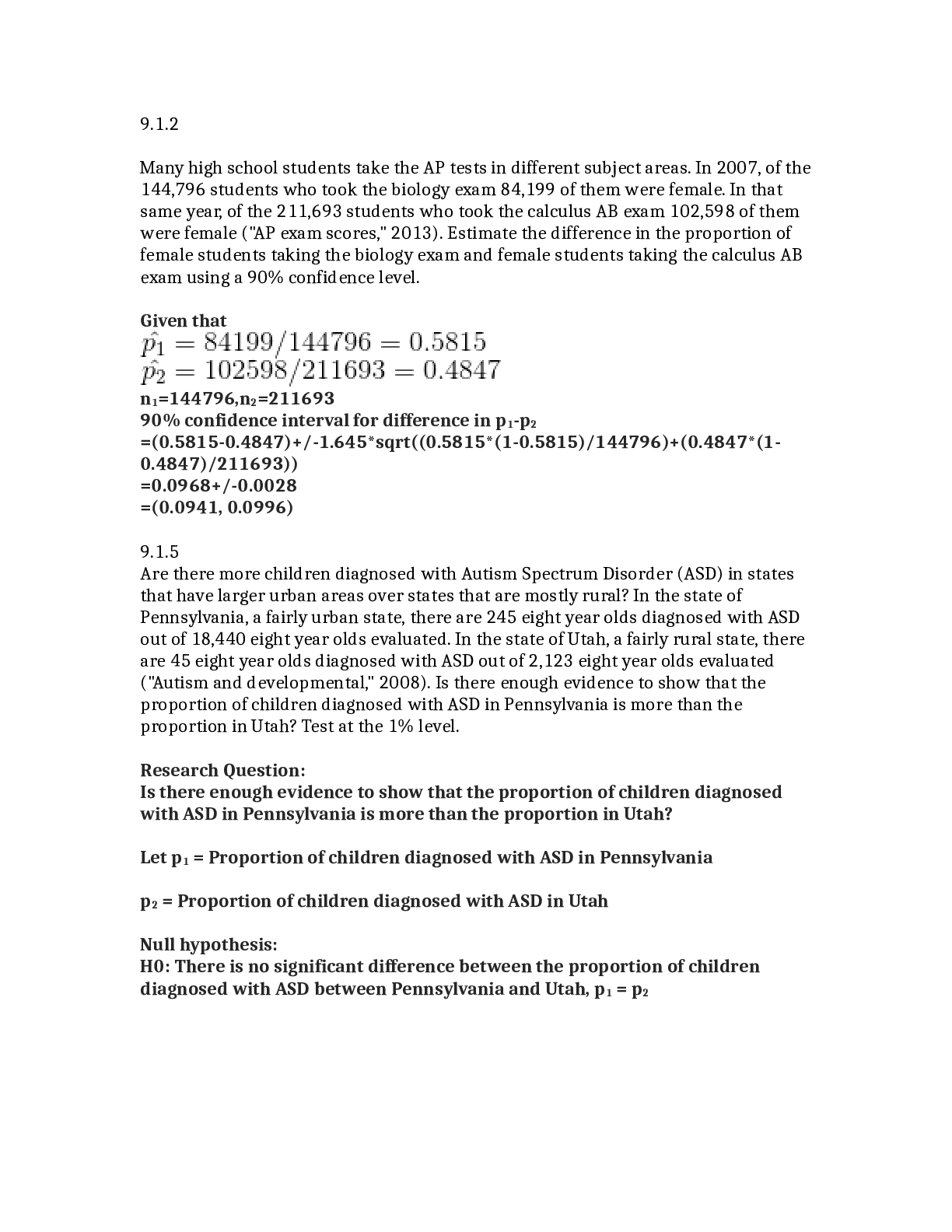
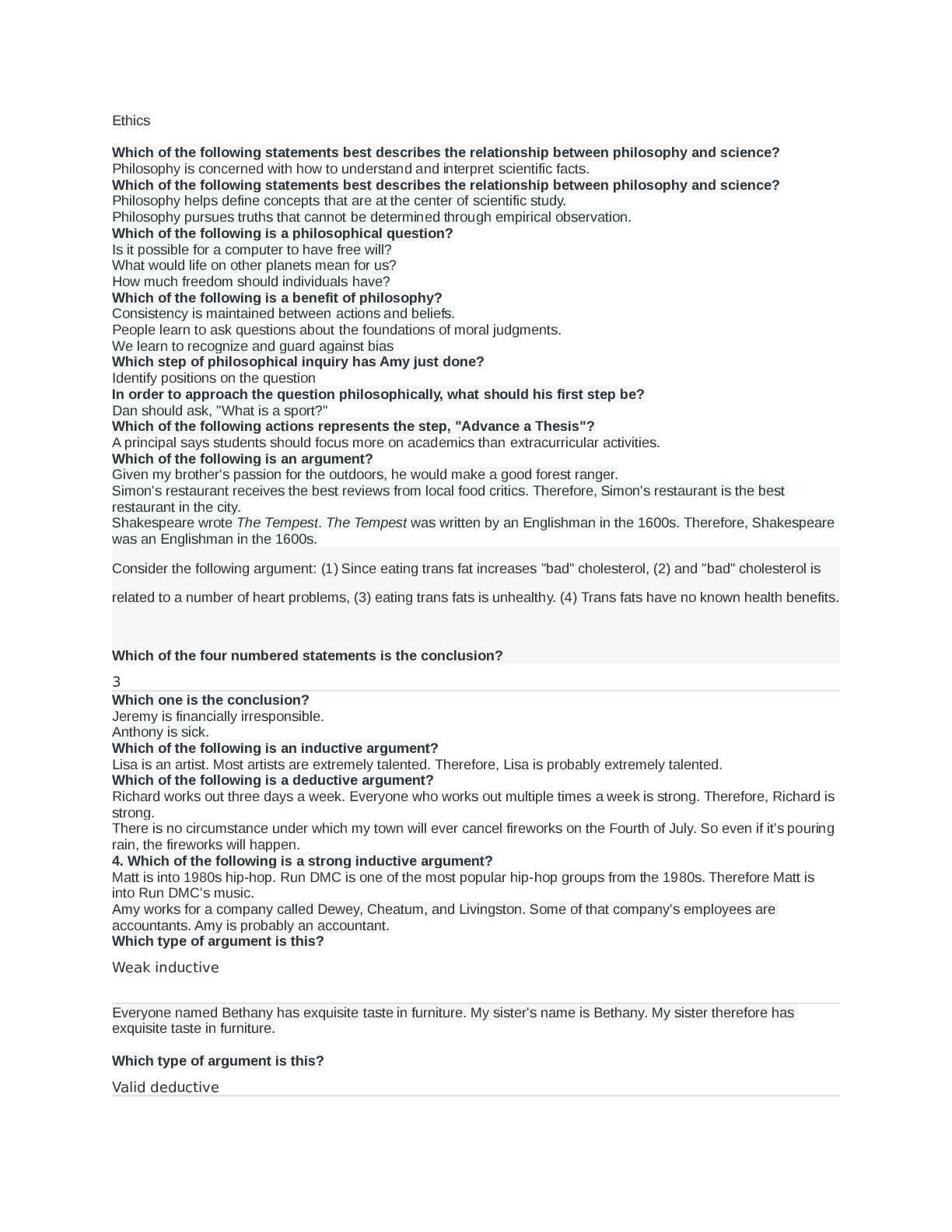

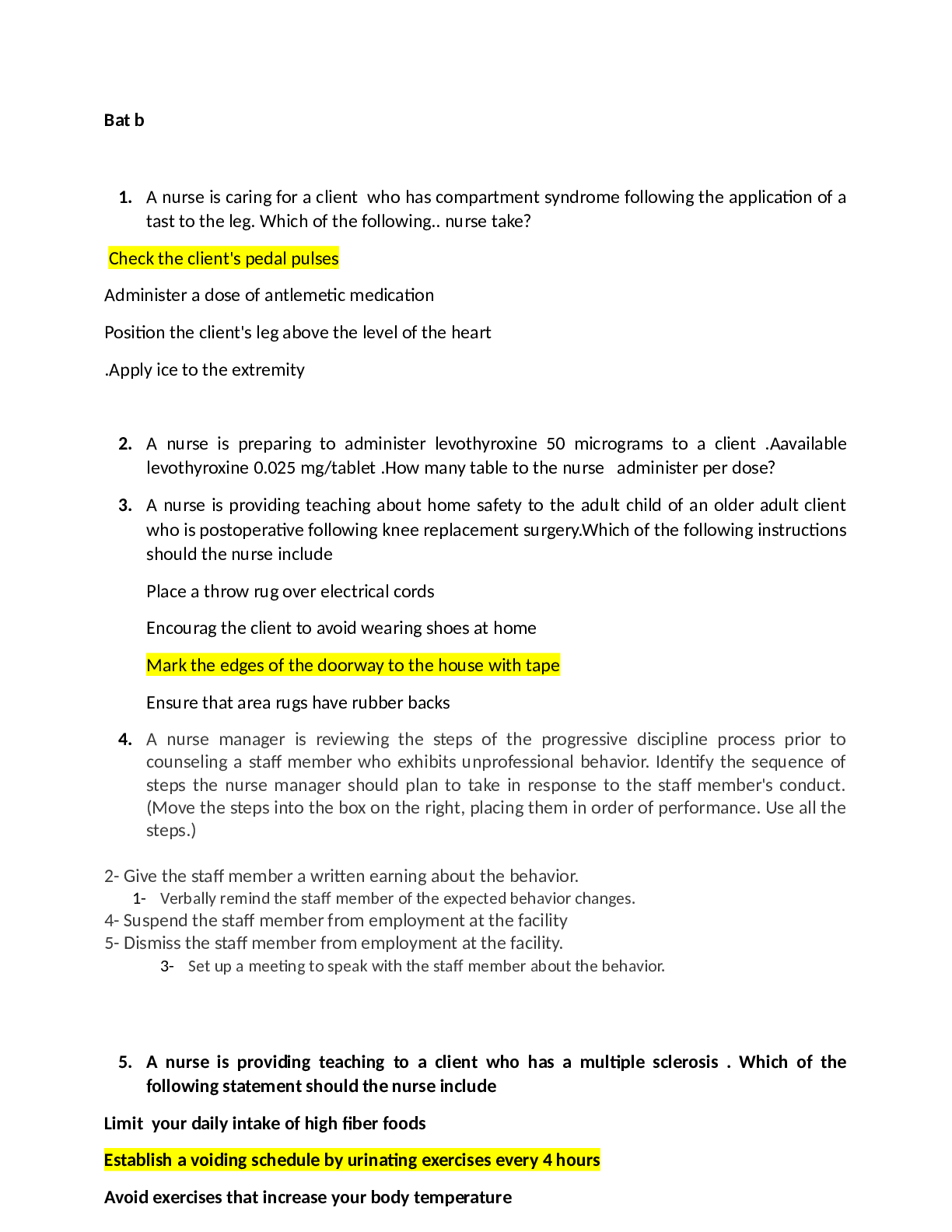

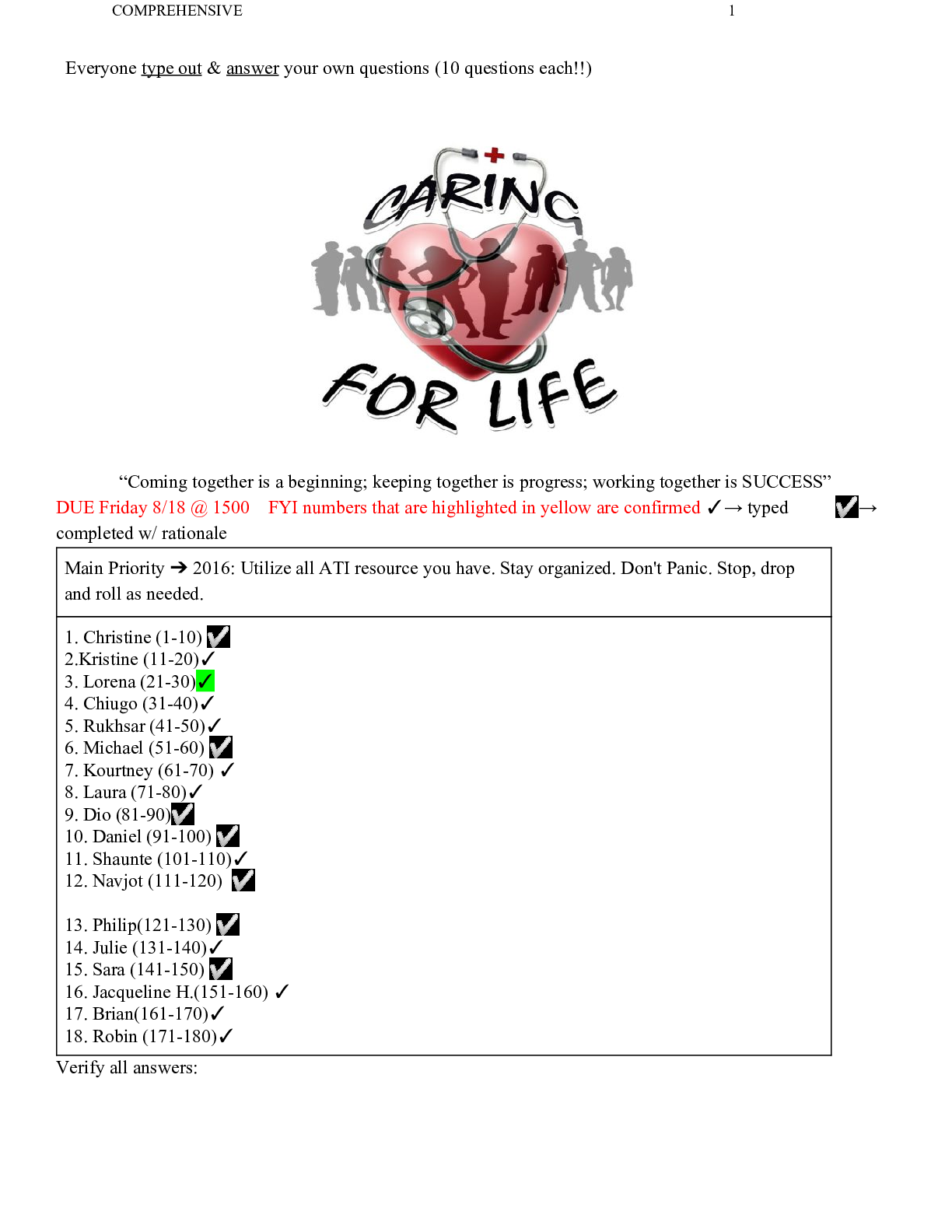
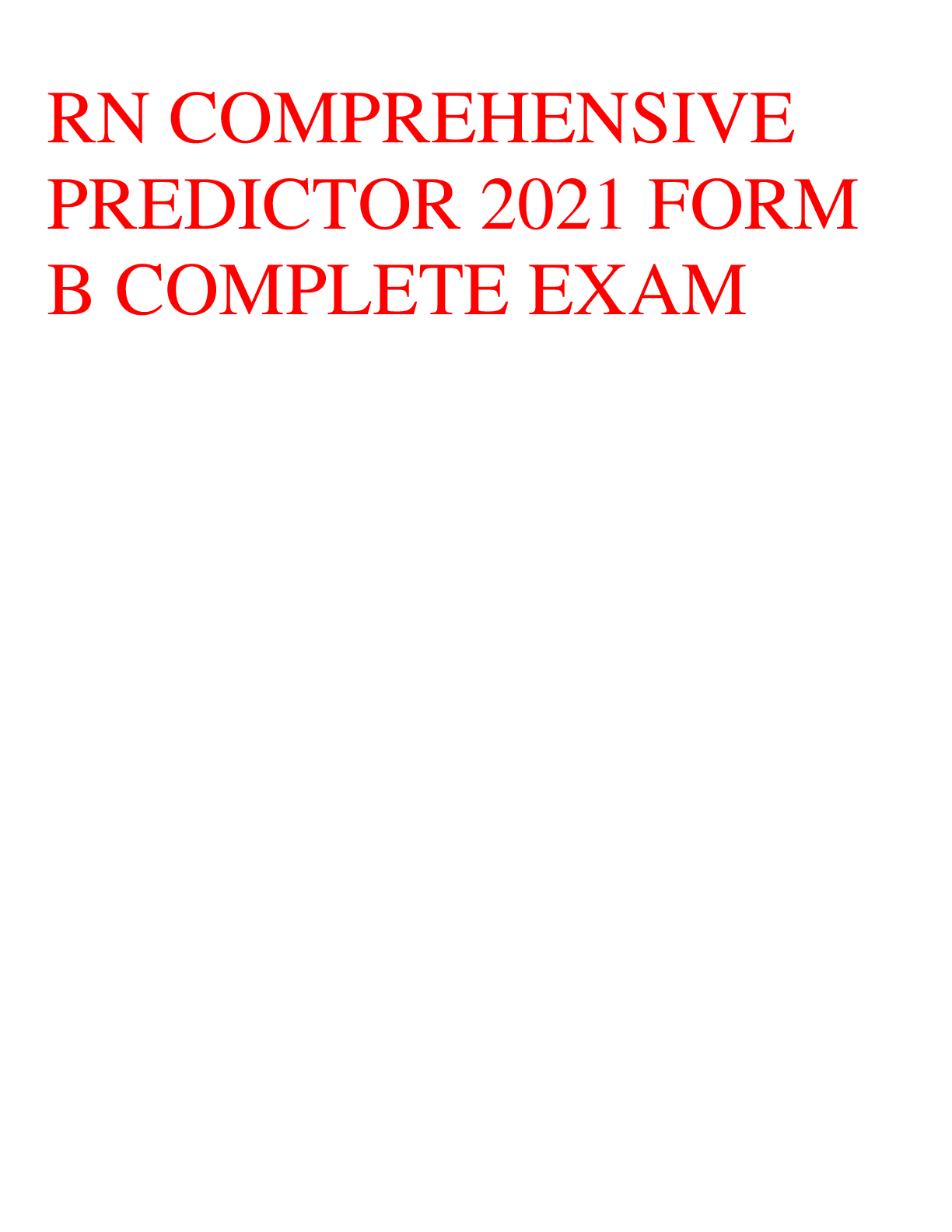

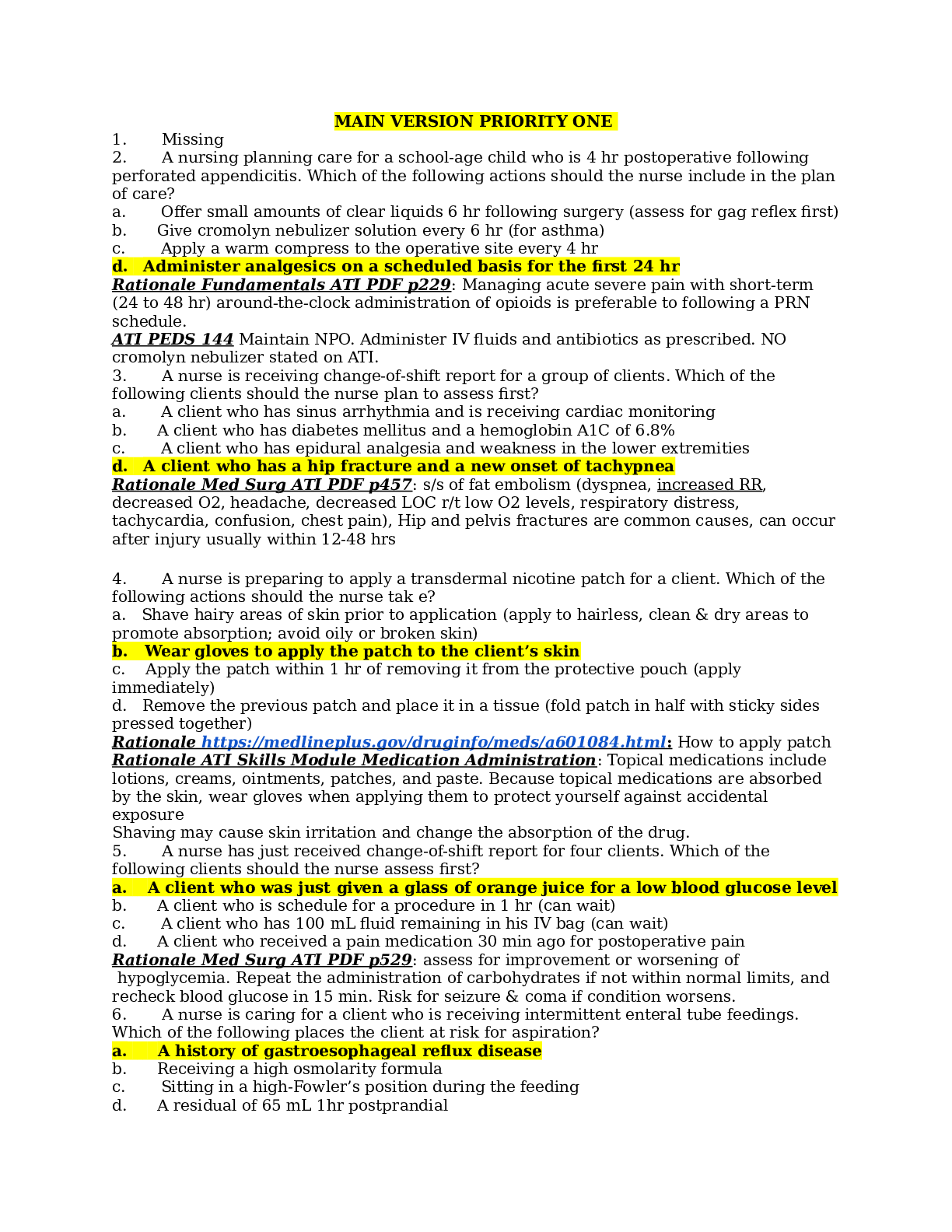
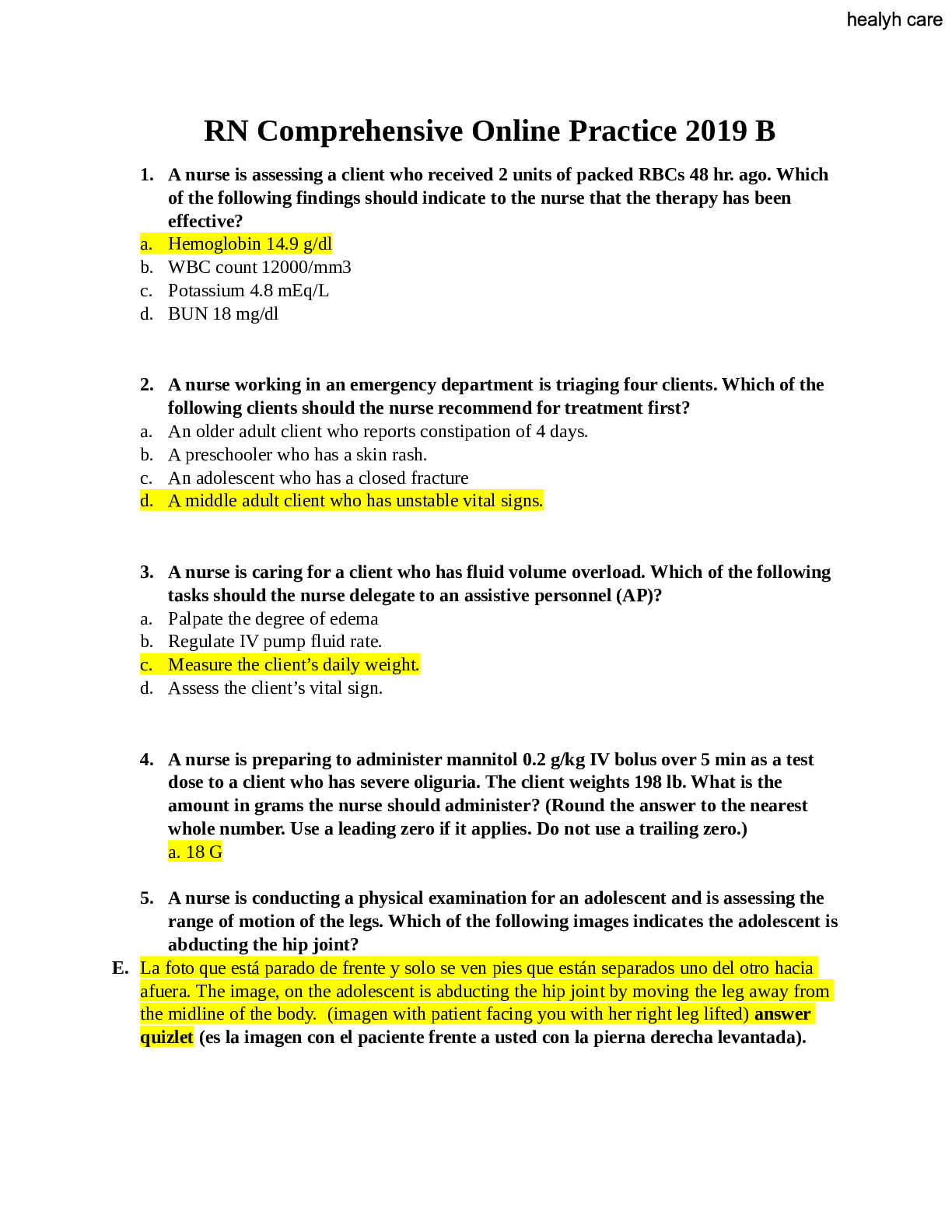
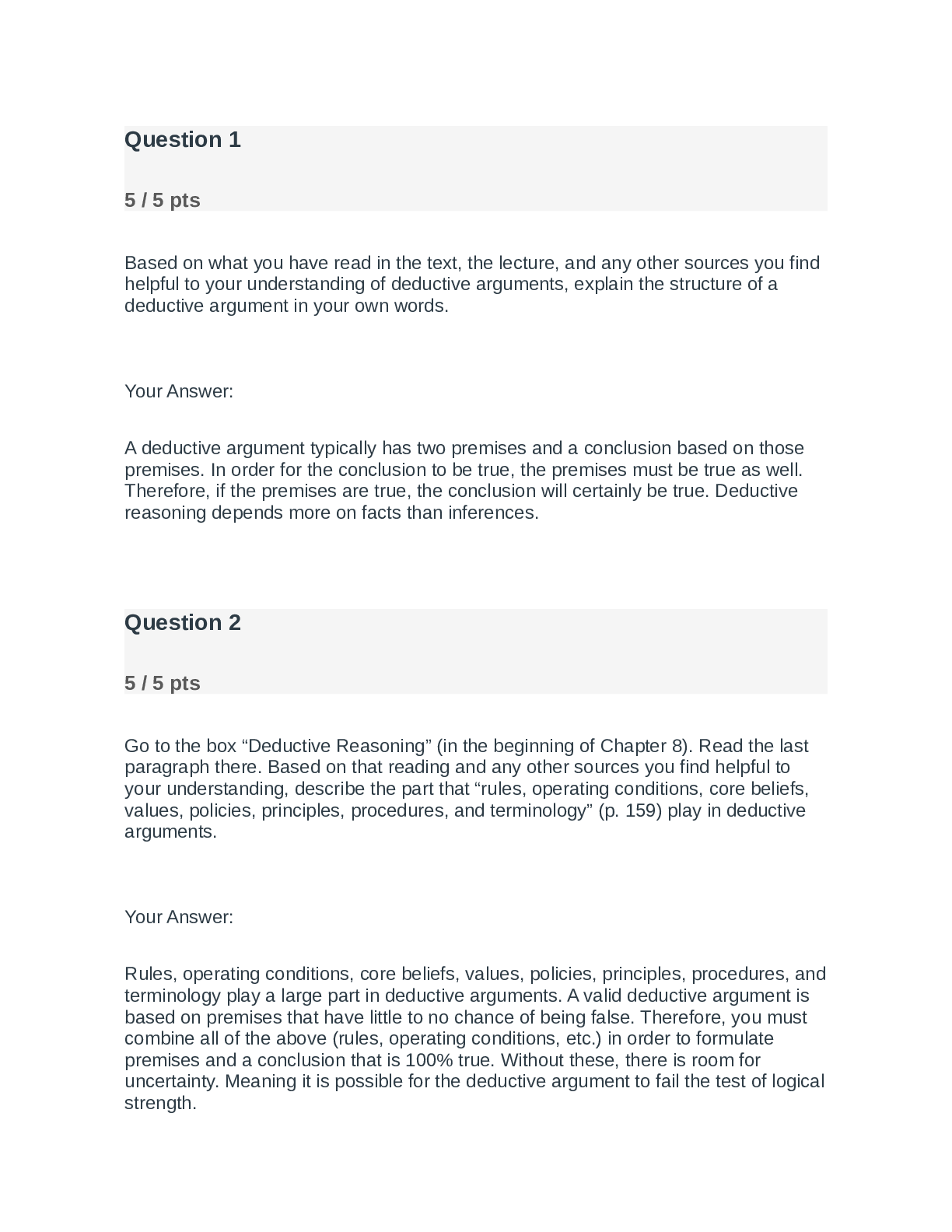



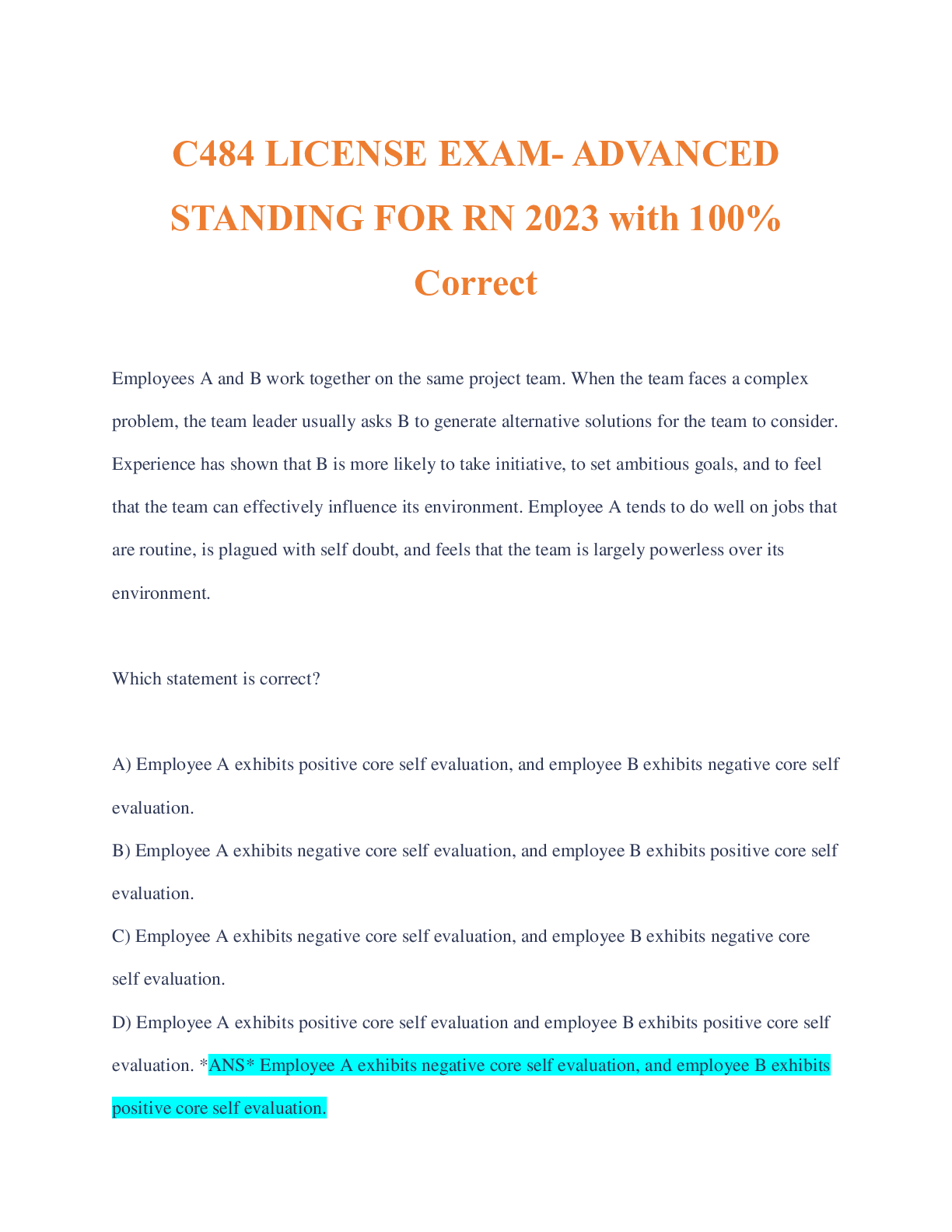
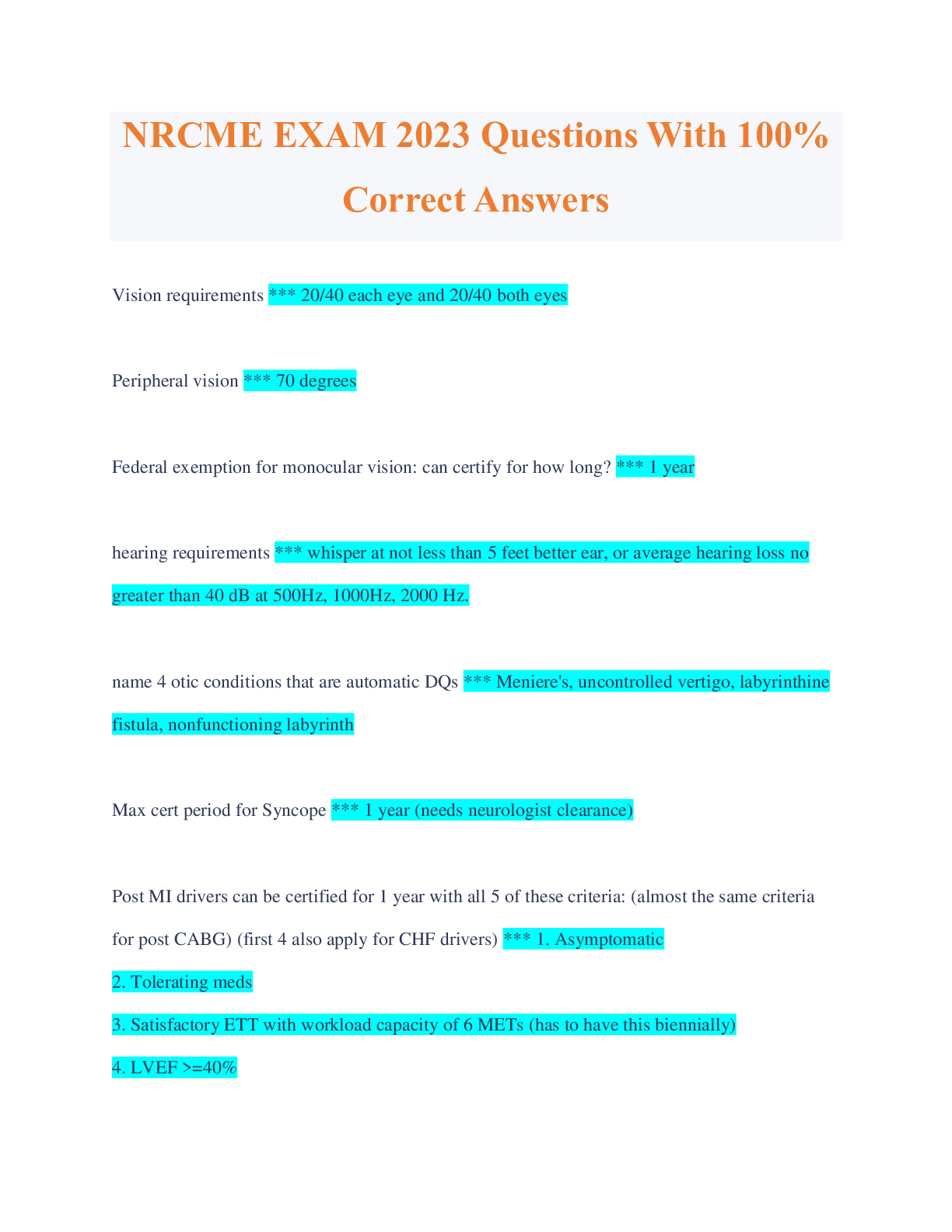

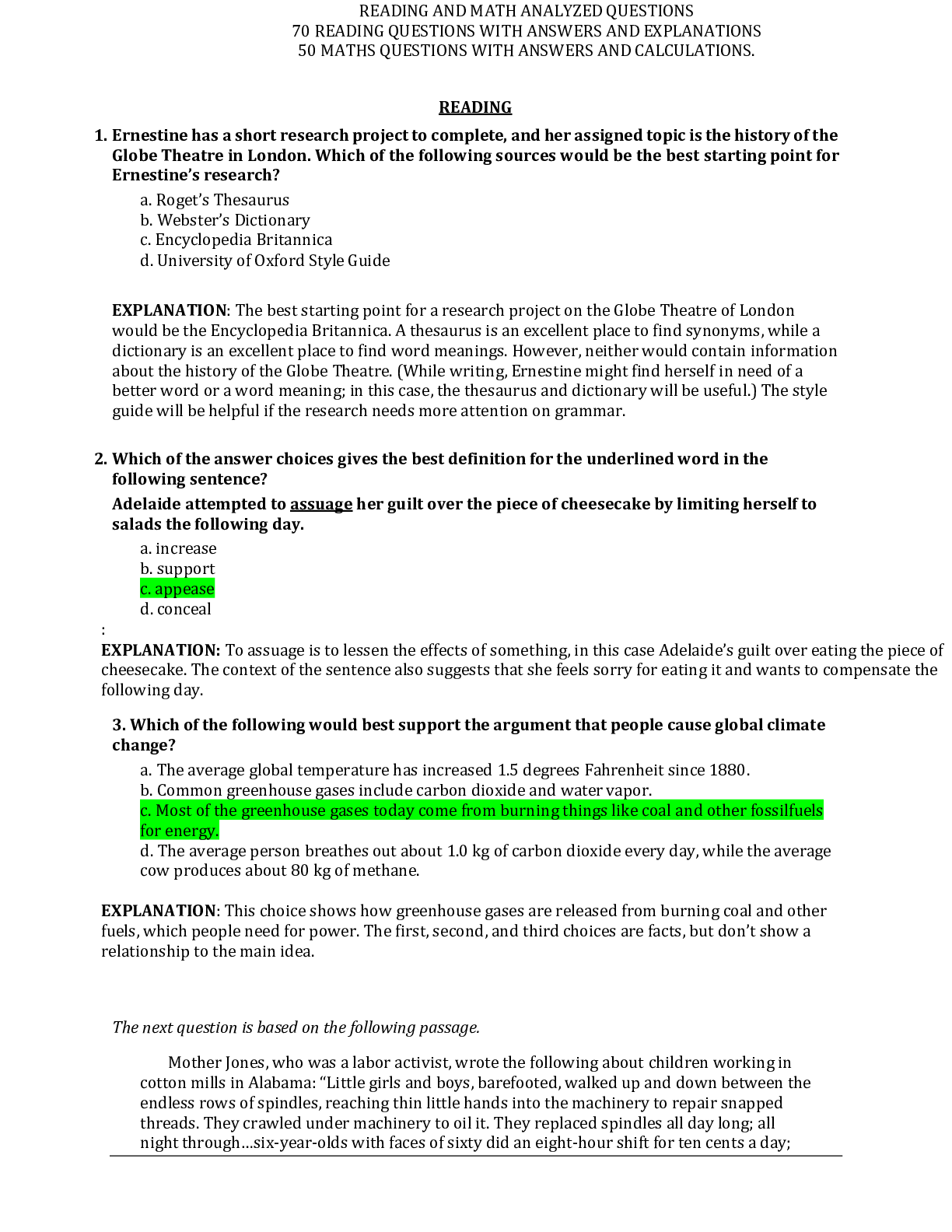
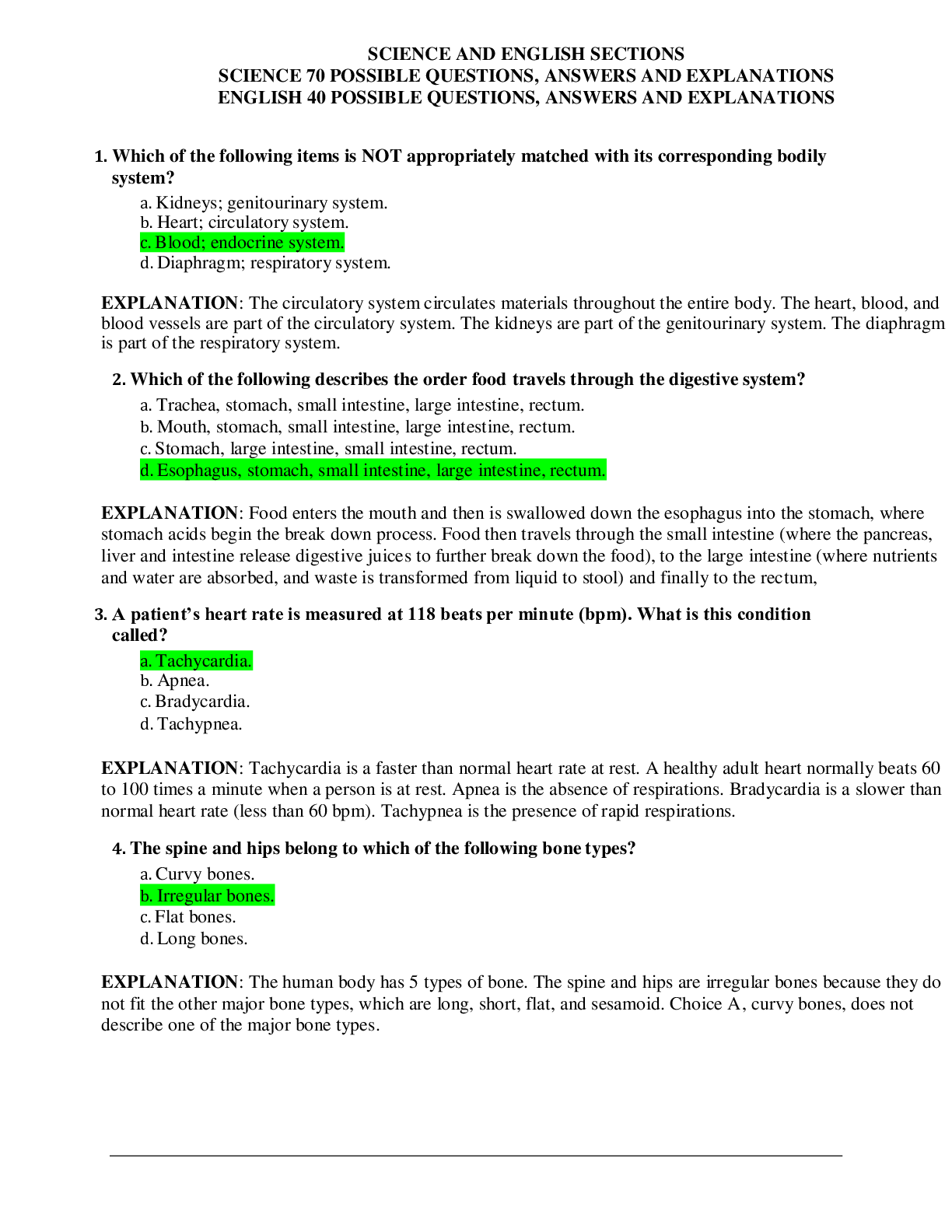
.png)

.png)
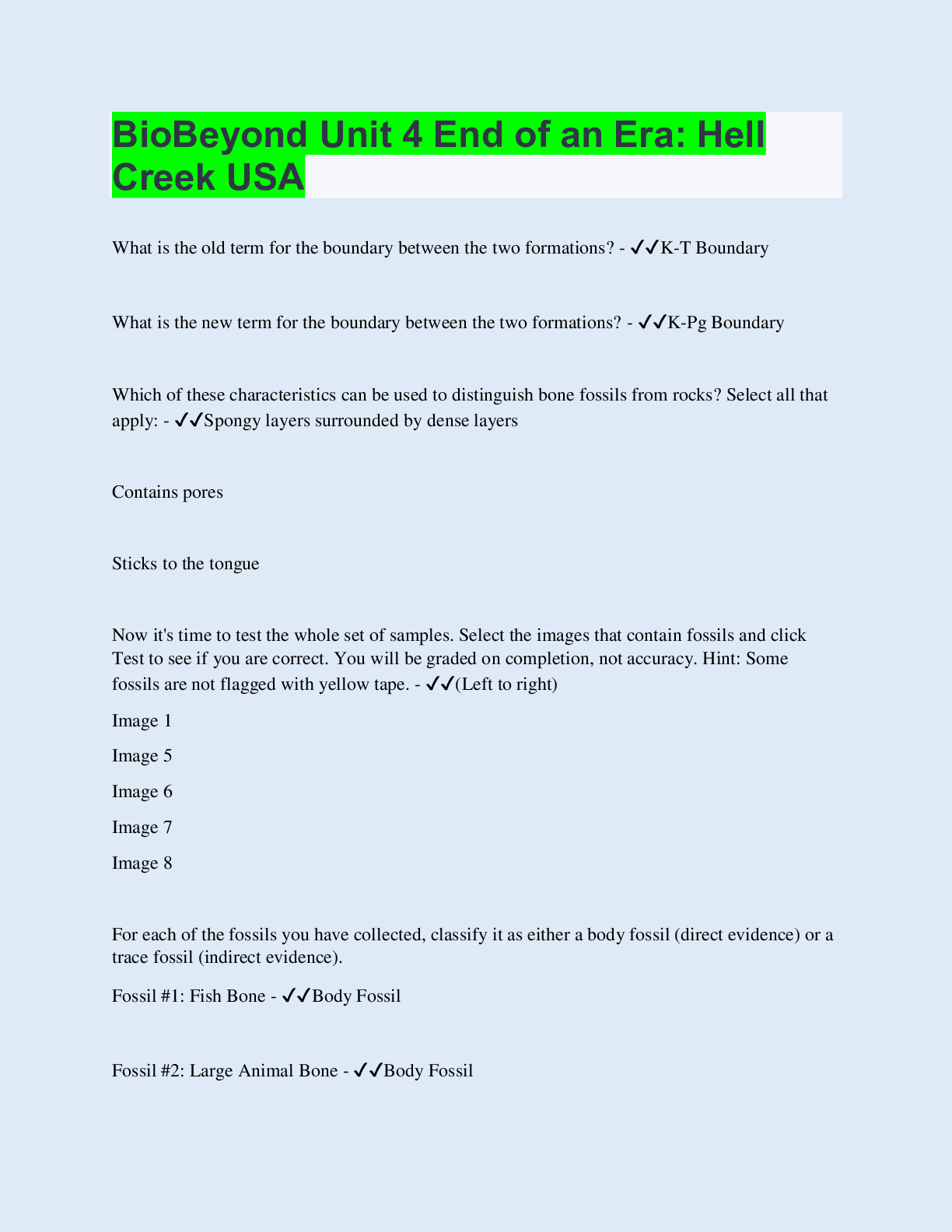
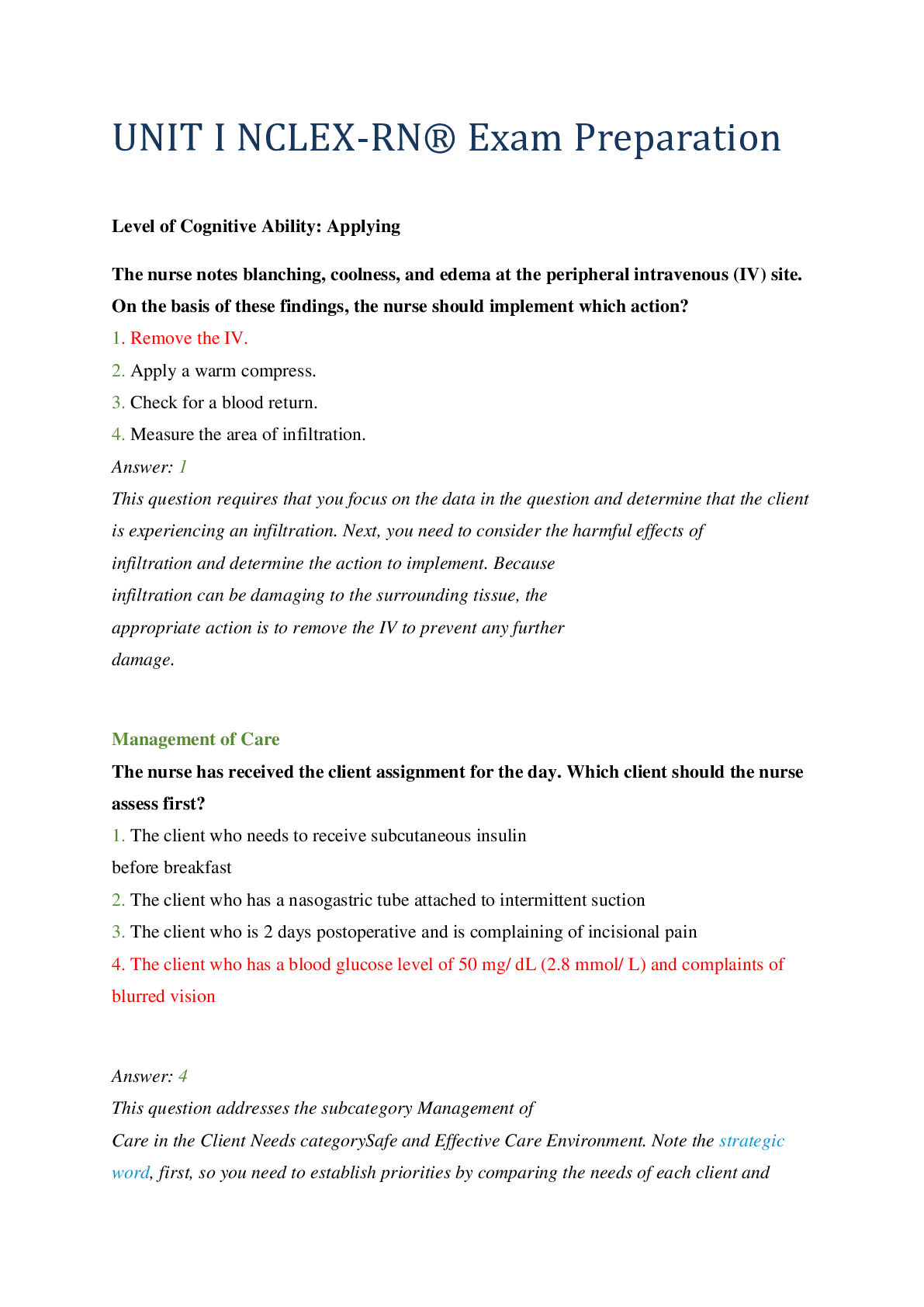
.png)
